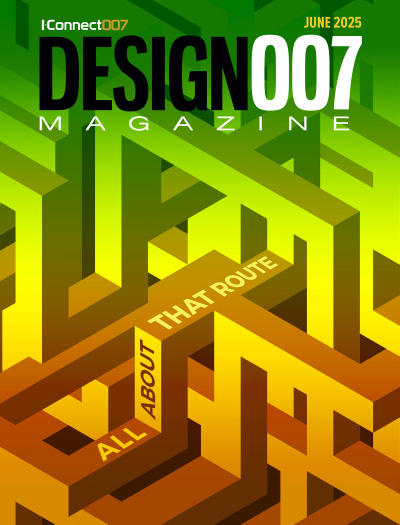-

- News
- Books
Featured Books
- design007 Magazine
Latest Issues
Current Issue
Showing Some Constraint
A strong design constraint strategy carefully balances a wide range of electrical and manufacturing trade-offs. This month, we explore the key requirements, common challenges, and best practices behind building an effective constraint strategy.

All About That Route
Most designers favor manual routing, but today's interactive autorouters may be changing designers' minds by allowing users more direct control. In this issue, our expert contributors discuss a variety of manual and autorouting strategies.

Creating the Ideal Data Package
Why is it so difficult to create the ideal data package? Many of these simple errors can be alleviated by paying attention to detail—and knowing what issues to look out for. So, this month, our experts weigh in on the best practices for creating the ideal design data package for your design.
- Articles
- Columns
- Links
- Media kit
||| MENU - design007 Magazine
Letter: Let's Reestablish the U.S. PCB Design Community
May 8, 2013 | Andy Shaughnessy, PCBDesign007Estimated reading time: 1 minute
Andy,
I read your March column this morning. I am back in the office after painting my roof last week--it's a required task when you own a flat-roofed house in Tucson.
Even though I am still suffering from sunburn, fluid dehydration, and assorted aches and pains associated with carrying five-gallon paint containers and tools up a ladder several times a day, your article on why a career as a PCB designer holds no attraction for the U.S. work force sticks out.
In the 1980s and 1990s, the best PCB designers could stand toe-to-toe with senior EEs, because they were well-educated, tried and true, experienced experts in all phases of the PCB design process. They just knew their trade. Companies rewarded PCB designers for their ability to always deliver quality time and again.
Then the bean counters looked at their salaries and saw that they were no longer working over drafting boards, but were now sitting in front of computers, and the bean counters deduced that PCB designers were getting lazy. Actually, they were doing more work in a shorter amount of time. As tools got stronger, instead of transferring the PCB design process knowledge into the tools, the bean counters deduced that everything was in the tools. Unfortunately, the bean counters’ premature actions killed the momentum of implanting this knowledge and truly taking PCB design to the next plateau. Then, the dotcom "promised land" boom and bust destroyed the Malcolm Baldrige manufacturing incentive.
So, the question is: What will it really take to reestablish the PCB design community as a significant new product contributor? More education? Smarter tools? Better standards? Transitioning from CAE/CAD/CAM to a true CIE/CID/CIM? Intelligent factories? Today’s experts mentoring the next generation of experts?
We need to recapture the power that the US PCB design community had in the 1980s and 1990s. Now there’s an idea for an article!
Regards,
Dan SmithRaytheon


